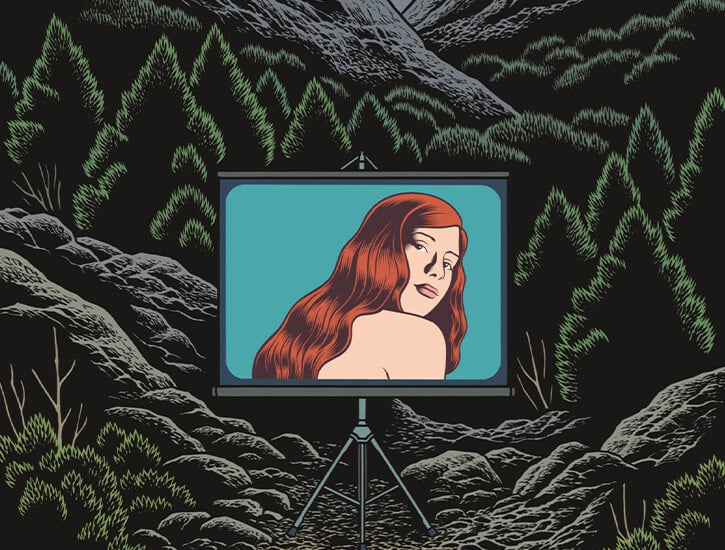Teenage Dreams
Coming of age in the graphic novels of Charles Burns From Final Cut| Credit to Charles Burns
From Final Cut| Credit to Charles Burns o
r
d
F
a
c
t
o
r
y
Final Cut by Charles Burns. Pantheon, 224 pages. 2024.
Kommix by Charles Burns. Fantagraphics, 80 pages. 2024.
No one draws house parties like Charles Burns. They seem to channel not the event itself but rather its memory, darkened by time and intoxication, though somehow utterly legible in its emotional salvage. I’ve come to anticipate the formal hallmarks of Burns’s parties: shadows spilling across living rooms; beers held like life rafts; silhouettes crowding backlit doors; faces turning inward, or else away from their interlocutor, as if they’ve already run out of things to say; a pervading physical grotesquerie that could be mistaken for monstrosity if it wasn’t simply puberty.
The settings themselves are both immaculately rendered and out of time, a composite of Pacific Northwest suburbia. For his teenaged protagonists, these parties are the anterooms of adulthood, opportunities for desperate bids and last calls, of ecstasies frustrated and postponed. As each character changes against his will, none finally grows up, or not precisely; rather, they grow in, burrowing toward memory and obsession, illusion and dream. In this darkly thrilling adolescent world, biology figures as a kind of crime against both spirit and flesh.
Burns’s new graphic novel, Final Cut, opens on just such a party. While teenagers get drunk and stoned in the living room, Brian sits alone in the kitchen drawing bizarre self-portraits. He’s interrupted by Laurie, who tells him she’ll be starring in the amateur horror film he’s about to shoot with a mutual friend, Jimmy. (Brian, Laurie, Jimmy: we find ourselves deep in the lore of twentieth-century Americana.) Brian is immediately smitten: “I know I should say something, but I can’t talk,” he thinks. Laurie is intrigued by his obvious talent but discomfited by the fluctuations in his tone and personality. They see a film together, go out for coffee, party with friends. The dyad they comprise—uncompromising artist and unwilling muse—lends the narrative its plaited texture. Their various metamorphoses, drawn with Burns’s exacting surreality, furnish the book with a charged aberrance. It’s a force that contorts the bildungsroman into shapes both fantastic and fascinating.
What makes the book exceptional is the combination of Burns’s extraordinary draughtsmanship, particularly the quality of his inking, and his narrative instinct.
Burns’s iconography—a visual language of tentacles, cocoons, eggs, and seminal fluid—is nothing new for longtime readers. He made his name with Black Hole, one of the essential American comics, originally a twelve-part series collected in 2005 into an omnibus graphic novel. It tells the linked stories of several teenagers in 1970s Seattle who become afflicted with “The Bug,” a sexually transmitted disease that causes extreme physical deformities. What makes the book exceptional is the combination of Burns’s extraordinary draughtsmanship, particularly the quality of his inking—forests, tents, campfires, diners, each a locus of perfect shadow—and his narrative instinct, akin to the nightmarish transgressions of Kōbō Abe or William S. Burroughs. The lives of the infected unfurl with a muted quality utterly at odds with the spectacle of their appearance. This persistent ambiguity underscores the ungovernable change and unexpected grace attending adolescence.
In lieu of a “bug,” Final Cutuses another mechanism to drive its characters into states of despondency and transcendence. We might call it obsession or, more prosaically, love: for films, people, places, ideas, and fantasies. Alongside a small group of friends, Brian and Laurie depart for a remote cabin in the woods to shoot an homage to Brian’s favorite movie, Invasion of the Body Snatchers. They film during the day and party at night. Nothing they create lives up to Brian’s expectations, a perfectionism that baffles and frustrates his cohort. The amateurish proceedings are thrown into sharp relief when Burns delves deeper into the richness and perversity of Brian’s fantasies. In these visions, a tentacled cerebellum excretes white casings inside of which humans sleep, the pod people of his mind. It is a realm of perfect idealism. Here no compromises are required: “No cheap special effects, no papier-mache models and nylon threads . . . this is real and perfect,” he thinks.
It is within the silky caverns of Brian’s imagination that Burns’s artistic gifts are most apparent. He burrows easily into the weird substratum of fantasy life, here a blend of sexual apprehension and wet, larval imagery. In a Burns composition, organic forms bleed into one another or echo across pages through different environments. The scrub brush on a mountain trail calls back to the patch of pubic hair we saw a few pages earlier; a forest viewed from above takes on the appearance of the floating brain with whom Brian identifies in daydreams; the tearing open of a cocoon resembles first a vagina and then a sleeping bag or a shroud. The cumulative effect is one of a complex network of symbols, a paranoiac dream of hyperconnectivity. It is a world alive with linkages, correlations, and unlikely relationships between objects animate and inanimate alike. It is also necessarily hermetic, foreclosed to whatever lies beyond the perverse logic of the dream.
The experience of reading Burns is governed by one’s ability to navigate this constellation of symbols and associative fragments. In Final Cut, the interpretive material is embedded within a range of formal devices: one and two-page spreads featuring both characters and landscapes; multi-panel sequences depicting old sci-fi and horror films (The Last Picture Show; the aforementioned Body Snatchers); internal monologues akin to more traditional literary fictions; potent hallucinations; and the social gatherings in and around which these other elements swirl. As words and objects move between each narrative layer, they become accretive, heavy with allusion. These bits of superdense material lend a heavy, even viscous feeling to Burns’s work, as if one is trudging through psychic mud. This stickiness refuses easy consumption. It is that rare thing: the unaccommodating artwork whose obstructions somehow draw the reader further in.
While Brian spirals into anxious obsession over his compromised film, Laurie falls for Tina, a friend who has joined the group at the cabin. After a pair of disastrous experiences together—a painful interaction with Brian’s drunken mother and a night of blackout intoxication—they finally break the tension with a kiss. (Earlier Laurie puts two fingers into the ocean and tastes the salt; later Tina dips those same fingers into her mouth in one of the parallel moments the book prizes.) Burns follows the kiss with a full-page image of Laurie issuing from one of Brian’s pods. Her eyes are lidded, as if just emerging from sleep, coming into some new form. This is instructive. As in the movie they’re making, life requires Brian and Laurie to cast characters, locate settings, supply dialogue, wear costumes, and create meaning from inchoate or incomplete material. They think they’re creating a film when they’re really fashioning novel versions of themselves.
Burns’s Kommix, also recently published, offers a different kind of foray into the Burnsian mythos. It collects dozens of covers for comics that never existed, gathering Burns’s career-long fascinations—adolescence, metamorphoses, sex, the comic form itself—into a sort of thematic compendium. Mining a variety of classic genre comics, these imagined works titillate with garish, sexually charged imagery that frequently veers into a deeply unsettling weirdness. Men and women expose themselves to strangers, hold the organs of aliens, discover giant secreting phalluses in the woods, take baths in pink gristle, get felt up by creeps, and fall into horny or dangerous dreams. Their titles—Teen Diary, Sex Decoy, Throbbing Heart—suggest the pulpy, fifties-era material Burns here reworks. Mixed with these anti-romantic images are covers that seem plucked from our potential futures, spreads featuring alien humanoids and post-apocalyptic wastelands, their illegible titles written in yet-to-be-invented scripts. (In a reflexive flourish, many of these feature Doug, the protagonist of a Burns trilogy collected in Last Look.)
Each figure is nudged just beyond its stereotypical quality, thereby freeing the latent monstrosity lurking in stock imagery.
The stand-alone cover is an ideal medium for Burns: a big, bold image to serve as an armature for his oblique obsessions. The drama of these compositions—strong-jawed men and beautiful, buxom women in stage-like arrangements—is reminiscent of earlier romance masters like Tony Abruzzo, whose visual choreography maximized dramatic impact in limited space. (Roy Lichtenstein’s Drowning Girlwas lifted from an Abruzzo splash page.) But Burns undercuts the wholesomeness of “girl comics” in various ways, complicating both visual expectation and collective memory. His tools are varied—obscene gesture, abnormal posture, the overtly sexualized interaction, or trademark surrealistic touch—though each relies on the image’s ostensible familiarity to work its defiling magic. Each figure is nudged justbeyond its stereotypical quality, thereby freeing the latent monstrosity lurking in stock imagery. We think we know something about these intimate moments—romantic embraces, lovers’ quarrels, violent outbursts of emotion—only to discover, upon closer inspection, we have no idea what is really about to unfold.
In reading Final Cut and Kommix back-to-back, I was compelled to consider how each book managed Burns’s anguished, sometimes antagonistic stance toward his characters’ physical and psychological changes. Compared to his longer-form works, this collection of covers offers a more circumscribed pleasure: robbed of sequential narration, the cover’s chosen moment can only tease a story that will never be told. This abdication lends additional dimension to Burns’s formal choices. Despite the oddity and lurid madness of Kommix, the covers themselves emanate a wonderful flatness, their full meaning held at arm’s length, suspended somewhere beyond our interpretive faculties. They depict clichés grown aware of themselves, revelations that plunge each image into its grotesque stasis. These figures are, in a sense, utterly immutable—a form of invincibility in Burns’s fragile world of perilous maturation—and finally at ease with its perpetual nature. Would that Brian or Laurie could be so lucky.
The cover of Kommix shows a woman watching from her window the same tentacled aliens that Brian fantasizes about. (In her hand she holds one of the creatures’ torn appendages.) Final Cut, too, enacts its own set of voyeuristic dramas. Brian’s eternal watching—be it movies or memories or his own illustrations of Laurie—renders portions of the narrative pointedly passive. His extemporaneous filming of Laurie is less the act of creative expression he believes it to be than a kind of imprisonment, a boy trapping a butterfly in a mason jar. “Oh, God . . . Just lookat you,” he mutters, keeping the camera on her face long after the scene has ended. It’s what he’s always doing—looking but not precisely seeing.
Stuck in his own head and entangled in the history of images public and private, he rebels against the demands of life by resigning himself to the role of permanent voyeur. Once recorded, Laurie enters the menagerie of his private world: unchanging, inert, protected. There he’ll find repose, but for how long? “It’s like going to a movie,” he thinks, “you sit in the dark and manage to escape for a few hours . . . but eventually the credits roll and the lights come on and it’s time to go home.” The fantasy is shattered; Brian’s selfhood is returned; change, as ever, is imminent. The book’s final pages show the eponymous final cut of the film. We see Laurie standing before an abandoned cabin on the beach. “There’s a door . . . a door that has to be opened,” Brian thinks. “But who’s inside? Who’s in there waiting for her?” It’s what was waiting for all of us at one point, something far more terrifying than floating brains or pod people: the banality of age and the rest of one’s life.



















